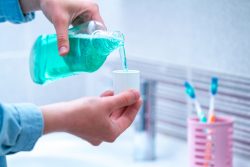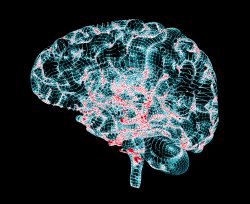Eating Gluten and How It Affects the Brain
 New Zealand researchers have made a significant discovery regarding wheat gluten and its effects on the brain. Their study revealed that adding gluten to a low- or high-fat diet led to inflammation in the hypothalamic region of the brain, responsible for metabolism regulation. These findings suggest that gluten may trigger an immune response similar to that seen in individuals with celiac disease. Furthermore, this research also highlights a connection between nerve cell inflammation and the development of metabolic diseases. Given the similarities between mice and humans, these findings are quite relevant to our understanding of human physiology.
New Zealand researchers have made a significant discovery regarding wheat gluten and its effects on the brain. Their study revealed that adding gluten to a low- or high-fat diet led to inflammation in the hypothalamic region of the brain, responsible for metabolism regulation. These findings suggest that gluten may trigger an immune response similar to that seen in individuals with celiac disease. Furthermore, this research also highlights a connection between nerve cell inflammation and the development of metabolic diseases. Given the similarities between mice and humans, these findings are quite relevant to our understanding of human physiology.
Gluten, a protein found in common grains like barley, wheat and rye, has been found to potentially cause inflammation in the enteric nervous system and the gastrointestinal tract as well as the brain. In a study with mice, male rodents were fed either a low-fat or a high-fat diet, with gluten later added. The results were significant – there was a noticeable increase in the number of astrocytes and microglia in a specific brain region called the arcuate nucleus (ARC) of the hypothalamus. This region is important for controlling metabolism.
Astrocytes and microglia, the immune cells present in the brain, share similarities with macrophages in the blood. These cells are known to contribute to inflammation. The hypothalamic region of the brain is responsible for managing metabolic functions that govern weight and blood sugar levels. Researchers proposed a hypothesis stating that inflammation in the hypothalamus caused by gluten can result in brain harm, weight gain, and compromised blood sugar regulation. Consequently, such conditions may heighten the risk of impaired memory function.
This study, though conducted on mice, is significant because mice and humans have many physiological similarities. Mice possess comparable circulatory, hormonal, digestive, reproductive, and nervous systems to humans. Therefore, it is plausible that the inflammation observed in mice could also occur in humans. During a period of 14 weeks, the mice were subjected to different diets: a low-fat diet consisting of 10% fat, a high-fat diet consisting of 60% fat, or these diets supplemented with 4.5% wheat gluten. This wheat gluten amount matches the average daily consumption of gluten by humans.
Gluten’s impact on body mass was different depending on the type of diet in male mice. When added to a low-fat diet, gluten had no effect on body mass. However, when added to a high-fat diet, gluten caused an increase in body mass and fat compared to a high-fat diet without gluten. The researchers also observed that adding gluten to the low-fat diet led to higher levels of C-reactive protein, an inflammation marker. Additionally, regardless of the type of diet, gluten led to a significant increase in the number of astrocytes and microglia in the hypothalamus.
This suggests that gluten may cause injury in the hypothalamus. Overall, this study provides evidence that dietary gluten can increase markers of inflammation in the hypothalamus.
To view the original scientific study click below:
Dietary wheat gluten induces astro- and microgliosis in the hypothalamus of male mice



 You may want to think twice before reaching for that bottle of mouthwash in your bathroom. A new study has revealed that the risks associated with these minty antimicrobials can have serious consequences for more than just your teeth. From skin irritation to cancer, certain ingredients have been linked to a wide range of side effects.
You may want to think twice before reaching for that bottle of mouthwash in your bathroom. A new study has revealed that the risks associated with these minty antimicrobials can have serious consequences for more than just your teeth. From skin irritation to cancer, certain ingredients have been linked to a wide range of side effects.  You may think non-nutritive sweeteners are harmless, but new research suggests otherwise. A team of scientists conducted a groundbreaking study to investigate the effects of popular sugar substitutes on our bodies and microbiomes. Their findings reveal that these seemingly innocent additives actually have the power to mess with our blood sugar levels.
You may think non-nutritive sweeteners are harmless, but new research suggests otherwise. A team of scientists conducted a groundbreaking study to investigate the effects of popular sugar substitutes on our bodies and microbiomes. Their findings reveal that these seemingly innocent additives actually have the power to mess with our blood sugar levels.  New study reveals alarming prevalence of dangerous listening practices and potential hearing loss risk for billions of people worldwide. Dangerous listening habits, both from personal listening devices and attending noisy entertainment venues, are widespread. About 23.81% of people engage in unsafe listening practices, while 48.20% are exposed to high noise levels in these venues. Shockingly, these habits could potentially put 1.35 billion individuals at risk of hearing loss globally.
New study reveals alarming prevalence of dangerous listening practices and potential hearing loss risk for billions of people worldwide. Dangerous listening habits, both from personal listening devices and attending noisy entertainment venues, are widespread. About 23.81% of people engage in unsafe listening practices, while 48.20% are exposed to high noise levels in these venues. Shockingly, these habits could potentially put 1.35 billion individuals at risk of hearing loss globally. In the quest to combat cognitive decline, a groundbreaking study has discovered a simple and cost-effective treatment: aromatherapy essential oils. Scientists investigated the potential of nightly aromatherapy to enhance cognitive abilities in aging individuals. By incorporating scents like lavender and rose into nightly routines, researchers witnessed an astounding 226% improvement in word recall. Additionally, the fascinating impact of aromatherapy oils on the left uncinate fasciculus, a crucial part of the brain, has been revealed and showed marked enhancement.
In the quest to combat cognitive decline, a groundbreaking study has discovered a simple and cost-effective treatment: aromatherapy essential oils. Scientists investigated the potential of nightly aromatherapy to enhance cognitive abilities in aging individuals. By incorporating scents like lavender and rose into nightly routines, researchers witnessed an astounding 226% improvement in word recall. Additionally, the fascinating impact of aromatherapy oils on the left uncinate fasciculus, a crucial part of the brain, has been revealed and showed marked enhancement. A groundbreaking study of nearly 1,500 adults has uncovered a startling link between reduced physical activity and a decline in quality of life among individuals aged 60 and above. Similarly, the study showed that an increase in sedentary behavior, such as watching TV or reading, further compounds this decline. These compelling findings emphasize the urgency of promoting and supporting an active lifestyle among older adults.
A groundbreaking study of nearly 1,500 adults has uncovered a startling link between reduced physical activity and a decline in quality of life among individuals aged 60 and above. Similarly, the study showed that an increase in sedentary behavior, such as watching TV or reading, further compounds this decline. These compelling findings emphasize the urgency of promoting and supporting an active lifestyle among older adults.  New research indicates that constipation may play a significant role in cognitive decline. This groundbreaking study highlights the interconnectedness of the body’s systems and the potential consequences when one system malfunctions. Although the study has not yet been published, the results were recently presented at a prestigious conference on Alzheimer’s disease. These findings shed light on the complex relationship between gut health and brain function.
New research indicates that constipation may play a significant role in cognitive decline. This groundbreaking study highlights the interconnectedness of the body’s systems and the potential consequences when one system malfunctions. Although the study has not yet been published, the results were recently presented at a prestigious conference on Alzheimer’s disease. These findings shed light on the complex relationship between gut health and brain function. In a recent study, scientists have discovered that the coordination between neuronal activity and the brain’s oxygenation is disrupted in older people. This finding sheds light on the crucial relationship between the brain and the cardiovascular system, as the brain relies on a significant portion of the body’s energy used – up to 20%. To meet the brain’s energy needs, specialized “neurovascular units” play a vital role in delivering enough energy supply to the neurons. This research provides new insights into the complex workings of the aging brain.
In a recent study, scientists have discovered that the coordination between neuronal activity and the brain’s oxygenation is disrupted in older people. This finding sheds light on the crucial relationship between the brain and the cardiovascular system, as the brain relies on a significant portion of the body’s energy used – up to 20%. To meet the brain’s energy needs, specialized “neurovascular units” play a vital role in delivering enough energy supply to the neurons. This research provides new insights into the complex workings of the aging brain. Warm weather and beautiful beaches may attract retirees to Florida, but scientists say it might not be the best place to live a long life. Recent research suggests that moderate cold temperatures can increase longevity and decrease the risk of age-related illnesses. This is due to the prevention of harmful protein clumping, which can lead to diseases like ALS and Huntington’s.
Warm weather and beautiful beaches may attract retirees to Florida, but scientists say it might not be the best place to live a long life. Recent research suggests that moderate cold temperatures can increase longevity and decrease the risk of age-related illnesses. This is due to the prevention of harmful protein clumping, which can lead to diseases like ALS and Huntington’s.  New research published in the Journal of the American Geriatrics Society suggests that the amount of fat present in a person’s muscle tissue could be a valuable predictor of cognitive decline in older adults. The study revealed a noteworthy connection between an accumulation of fat in the thigh muscle over a period of 5 years and an increased likelihood of cognitive decline. This association persisted even after considering important factors such as body weight, other fat deposits, muscle traits, and typical dementia risk factors.
New research published in the Journal of the American Geriatrics Society suggests that the amount of fat present in a person’s muscle tissue could be a valuable predictor of cognitive decline in older adults. The study revealed a noteworthy connection between an accumulation of fat in the thigh muscle over a period of 5 years and an increased likelihood of cognitive decline. This association persisted even after considering important factors such as body weight, other fat deposits, muscle traits, and typical dementia risk factors.